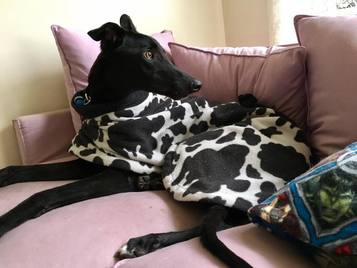GSN greyhounds & the adoption process
Our greyhounds live in foster homes until they find their adoption home.
This introduces them to pet life, toilet-training and they learn how to behave inside the home as well as all the new experiences they get on their daily walks. Many spend time in a home with another dog, some with a cat.
Prior to going into foster care, all GSN dogs are:
Prior to going into foster care, all GSN dogs are:
- health checked and teeth cleaned
- de-sexed
- C5 vaccinated
- wormed, heartworm tested, flea treated and
- micro-chipped.
We are careful custodians of our greyhounds.
As a safety net for greyhounds who may not otherwise have a chance at finding a forever home, we do our very best to find the right home to match our greyhounds' needs.
Each greyhound is an individual, they are not a one-size-fits-all dog, so it is our mission to match them with homes that will meet their needs and make their adopters happy with the match.
Each greyhound is an individual, they are not a one-size-fits-all dog, so it is our mission to match them with homes that will meet their needs and make their adopters happy with the match.
The Adoption Process
 Jack in his designer coat
Jack in his designer coat
1. MEET THE GREYHOUND
Once GSN have agreed that a particular greyhound might be suitable for you, we will provide you with the foster carer's number, so that you can talk directly to them about the dog. During this phone call, if you feel the dog sounds a good candidate for your family/circumstances, you can arrange to meet the greyhound and the foster carer. Obviously, if you already own a dog, it is important for them to come to the 'meet and greet' to ensure that they get on well too.
2. HOME CHECK
If you decide to adopt a greyhound, then GSN will organise for a home inspection to ensure that your fences are adequate to secure a greyhound and it will have appropriate shelter out of the weather when it is outside during the day. This may simply be access to a garage with a warm bed away from drafts. We also make sure that the greyhound will be allowed to sleep inside the house.
We do expect our greyhounds to be adopted as "indoor dogs", but due to toileting needs or the playful nature of younger greyhounds you may need to leave them outside, if leaving them for extended periods.
3. PAYMENT
An adoption fee of $295 applies to recover some of the costs associated with rescuing and re-homing.
This can be paid by Bank Transfer - Please deposit to:
Greyhound Safety Net Inc
BSB: 633000
Account: 128262920
4. PICKING UP YOUR NEW GREYHOUND
This is done at a time convenient to you and the foster-carer.
Your new greyhound will come with a collar and lead, and a warm coat.
GSN will provide you with the greyhound's pedigree and history, the vaccination and de-sexing certificates, and importantly we will organise and pay to have the greyhound's microchip changed into your name, so that you can register your dog with your local Council.
If you are unsure about adopting a greyhound, you may wish to foster one before making a decision.
Check out our 'Fostering a Greyhound' page.
If you are interested in Greyhound Adoption or Greyhound Fostering, please complete our On-line Application. We will be happy to discuss your preferences and needs.
Once GSN have agreed that a particular greyhound might be suitable for you, we will provide you with the foster carer's number, so that you can talk directly to them about the dog. During this phone call, if you feel the dog sounds a good candidate for your family/circumstances, you can arrange to meet the greyhound and the foster carer. Obviously, if you already own a dog, it is important for them to come to the 'meet and greet' to ensure that they get on well too.
2. HOME CHECK
If you decide to adopt a greyhound, then GSN will organise for a home inspection to ensure that your fences are adequate to secure a greyhound and it will have appropriate shelter out of the weather when it is outside during the day. This may simply be access to a garage with a warm bed away from drafts. We also make sure that the greyhound will be allowed to sleep inside the house.
We do expect our greyhounds to be adopted as "indoor dogs", but due to toileting needs or the playful nature of younger greyhounds you may need to leave them outside, if leaving them for extended periods.
3. PAYMENT
An adoption fee of $295 applies to recover some of the costs associated with rescuing and re-homing.
This can be paid by Bank Transfer - Please deposit to:
Greyhound Safety Net Inc
BSB: 633000
Account: 128262920
4. PICKING UP YOUR NEW GREYHOUND
This is done at a time convenient to you and the foster-carer.
Your new greyhound will come with a collar and lead, and a warm coat.
GSN will provide you with the greyhound's pedigree and history, the vaccination and de-sexing certificates, and importantly we will organise and pay to have the greyhound's microchip changed into your name, so that you can register your dog with your local Council.
If you are unsure about adopting a greyhound, you may wish to foster one before making a decision.
Check out our 'Fostering a Greyhound' page.
If you are interested in Greyhound Adoption or Greyhound Fostering, please complete our On-line Application. We will be happy to discuss your preferences and needs.
Cats and Greyhounds
The vast majority of greyhounds are not cat-friendly. Hence, we find that greyhounds who can happily live with a cat are generally very timid, often don’t like going for walks and may freeze when they get a fright on a walk. Most are best suited to live in a home with another dog, so that they can slowly build their confidence in the world.
Regardless, they take a lot of time and dedication by their new owners to slowly bring them out of their shells and they may never be social butterflies outside their home environment. So please consider whether you have the time and commitment to invest in a cat-friendly greyhound before you apply.
Regardless, they take a lot of time and dedication by their new owners to slowly bring them out of their shells and they may never be social butterflies outside their home environment. So please consider whether you have the time and commitment to invest in a cat-friendly greyhound before you apply.
Apartment Life and Greyhounds
Living in an apartment with a greyhound, takes commitment to meet the dog’s needs and to care for it.
Just like people, greyhounds need to go to the toilet every few hours and definitely first thing on waking up in the morning. So unless you are home a lot or have a dog walker this is not easy to manage. Even when you have a totally secure area for the dog to toilet, greyhounds are very large dogs that produce a lot of excrement. A greyhound and an apartment are not always an ideal mix, so please consider the following before you apply to adopt or foster a Greyhound.
Just like people, greyhounds need to go to the toilet every few hours and definitely first thing on waking up in the morning. So unless you are home a lot or have a dog walker this is not easy to manage. Even when you have a totally secure area for the dog to toilet, greyhounds are very large dogs that produce a lot of excrement. A greyhound and an apartment are not always an ideal mix, so please consider the following before you apply to adopt or foster a Greyhound.
- GSN will not place a greyhound in a home where it has unsupervised access to a standard height balcony railing, as they are big dogs that could easily jump over with fatal consequences. (Minimum height for balcony railing must be 1.5 metres for a greyhound.)
- Generally young greyhounds under 5 years, are too lively to be suitable for apartment living as they need more stimulation and may become destructive if left alone for long periods of time.
- Greyhounds cope better in an apartment if you are not working full time and are able to walk them during the day, play with them and give them the companionship they crave.
- You need to be prepared to take your greyhound outside to toilet, at least 4 times a day, unless your balcony is the toilet area and it is securely built up to a height of at least 1.5 metres.
- Greyhounds cannot last 8-9 hours during the daytime without being toileted. So if you work full-time we do not recommend greyhounds for apartment living. You will need to have a dog-walker come at lunchtime to toilet your dog. You will need to toilet the dog first thing every morning when it wakes, take them for a walk after their breakfast, and be home promptly from work to walk them again (no Friday night drinks with your working mates or catching up directly after work!) and then last thing before you go to bed.
- Obviously, being able to take your greyhound to work or using a dog-walker or doggie-day care centre will assist you to manage some of these issues, but this would need to be done each day.
LINKS |
© COPYRIGHT 2019. ALL RIGHTS RESERVED.
|

